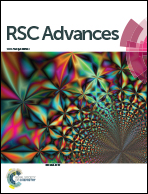The fabrication of TiO2-supported clinoptilolite via F− contained hydrothermal etching and a resultant highly energetic {001} facet for the enhancement of its photocatalytic activity†
Abstract
TiO2-supported clinoptilolite (TiO2/CP) was synthesized in the presence of F− ions. Various characterizations demonstrated that the particle size of loaded TiO2 increased linearly with an increase in the temperature and concentration of F− ions. In particular, the additive F− ions were favored to produce the mutually independent co-exposed {001} and {101} facets of loaded TiO2, while TiO2/CPs synthesized in the absence of F− ions were dominated by the thermodynamically stable {101} facet. As photocatalysts for the removal of crystal violet or methyl orange dyes under UV-irradiation in aqueous solutions, TiO2/CPs (ACP6) synthesized in the presence of F− ions significantly improved the degradation efficiency, as compared to ACP3 obtained in the absence of F− ions. These results elucidated that the highly energetic {001} exposed facet, large particle size and fine dispersion of loaded TiO2 in TiO2/CP accounts for its best photocatalytic performance. The effected mechanism of operational parameters on the degradation performances is proposed.



 Please wait while we load your content...
Please wait while we load your content...